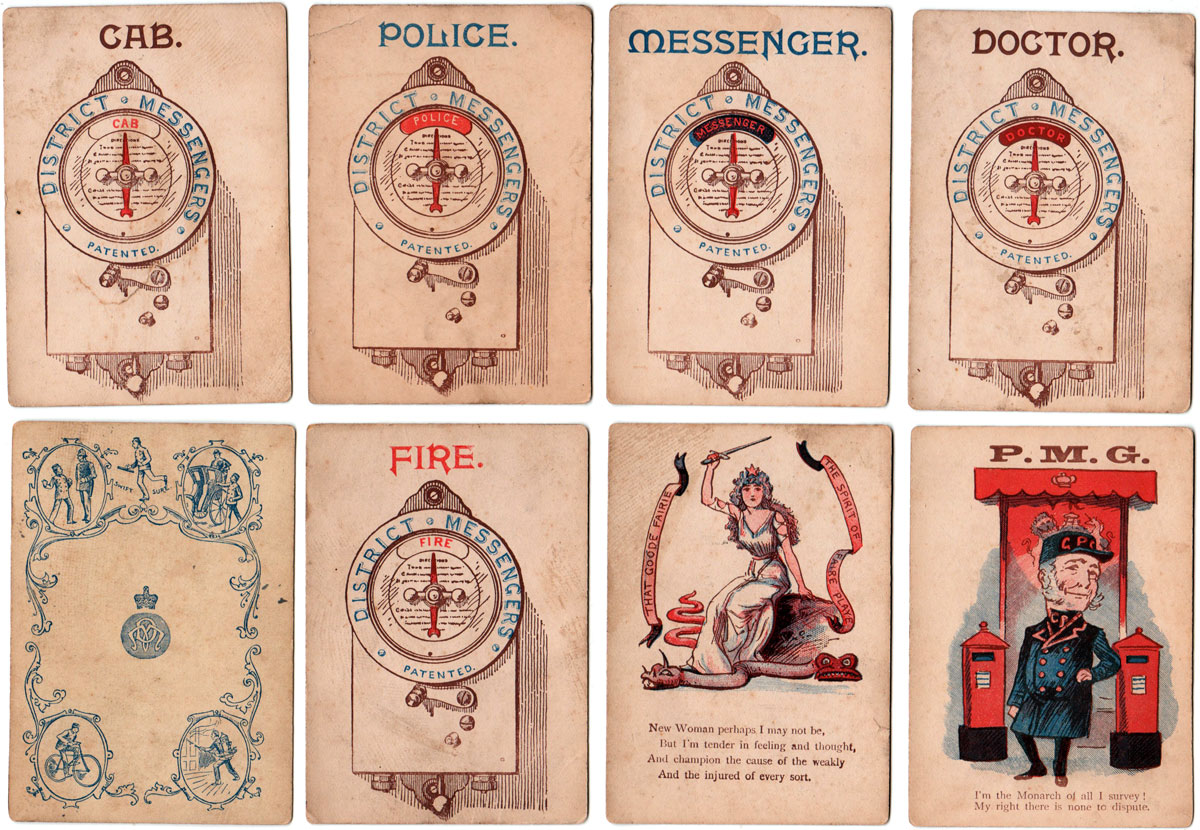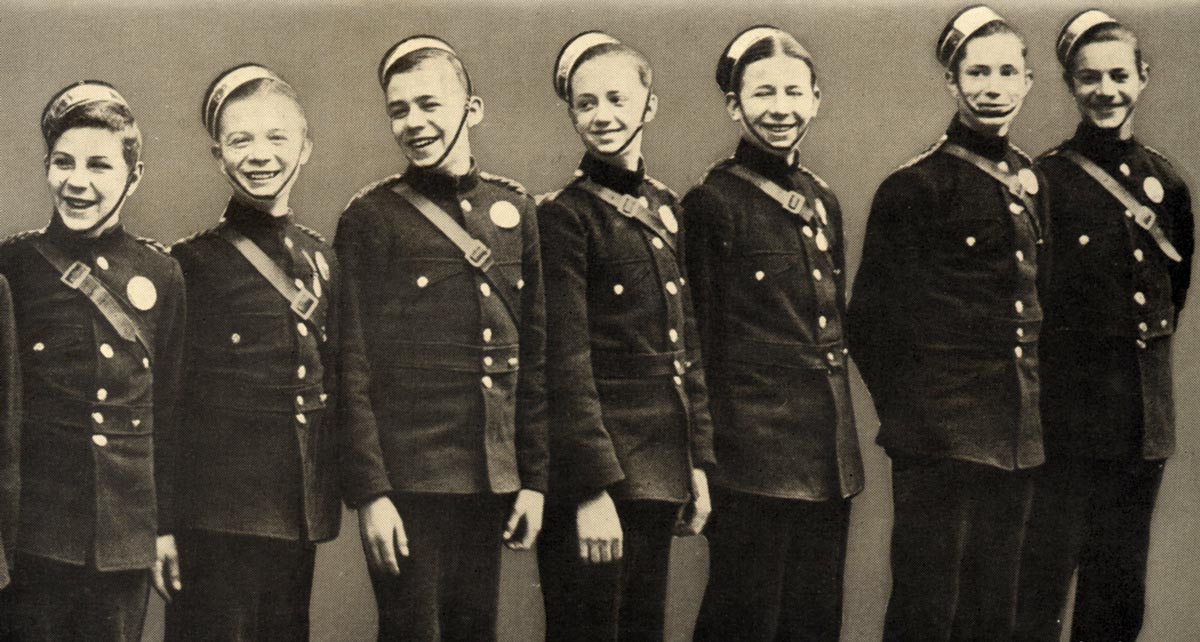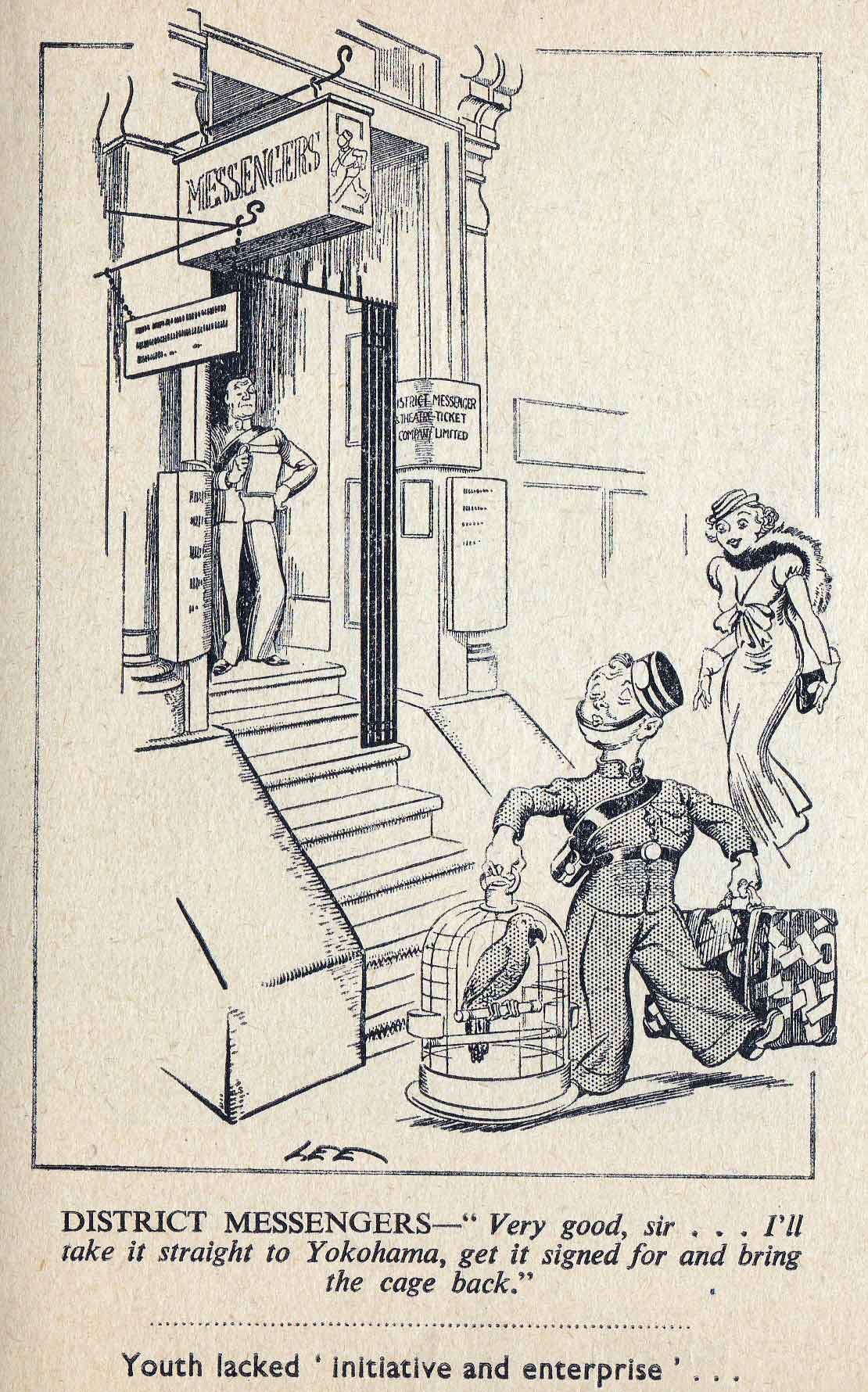District Messenger
District Messengers were uniformed young men wearing little pill-box hats and mounted on bicycles who fulfilled urgent tasks and were paid by the mile
District Messengers were uniformed young men between 10 and 18 years of age who, wearing little pill-box hats and mounted on bicycles, fulfilled urgent tasks or carried telegrams through urban streets and were paid by the mile. This unusual card game, probably dating from the early 1900s, is based on this theme, and clearly embraces the values of capitalist ideology. There are twenty-six cards labelled A, B, C ... Z, plus twelve cards numbered 1, 2, 3 ... 12 each with a short rhyme at the bottom, plus seven additional cards making a total of 45 cards. The game was probably inspired by earlier editions of a board game of the same name published in America by McLoughlin Brothers in the 1880s patterned on the “rags to riches” idea.
The images show servile Messenger boys in the streets of London and other places, ever ready to go anywhere and do anything, fulfulling errands and duties for wealthy patrons who are depicted as being of higher social status and worthy to be served. Many of the rhymes refer to the low wages and unfavourable conditions of employment endured stoically by the Messenger boys, as well as their unquestioning sense of duty.
The style of clothing, the absence of motorised vehicles as well as a number of the business names or products featured in the artwork, correspond with a date of late 19th or early 20th century. For example: Sloper’s Pills, Dash & Bellamy Fishmonger, V. Benoist 36 Piccadilly, Streeter & Co (1873-1905), Morel Cobbett & Son, Hewetson’s Tottenham Court Road London, Bertram Upholsterers, Simpson & Sons livery outfitters and Dr. Jaeger’s Sanitary Woollen System, which had received its first Royal Warrant by 1910, all operated around the turn of the century.

Above: “District Messenger” card game, early 1900s.

Above: District Messenger boys in the 1930s.
See also Katz, Leslie: 'Who Ya Gonna Call?': District Messengers in the Sherlock Holmes Adventures►

Above: cartoon in a book called “London Laughs” containing cartoons by “Lee” in the Evening News between 1934 and 1951.

By Rex Pitts (1940-2021)
Member since January 30, 2009
Rex's main interest was in card games, because, he said, they were cheap and easy to get hold of in his early days of collecting. He is well known for his extensive knowledge of Pepys games and his book is on the bookshelves of many.
His other interest was non-standard playing cards. He also had collections of sheet music, music CDs, models of London buses, London Transport timetables and maps and other objects that intrigued him.
Rex had a chequered career at school. He was expelled twice, on one occasion for smoking! Despite this he trained as a radio engineer and worked for the BBC in the World Service.
Later he moved into sales and worked for a firm that made all kinds of packaging, a job he enjoyed until his retirement. He became an expert on boxes and would always investigate those that held his cards. He could always recognize a box made for Pepys, which were the same as those of Alf Cooke’s Universal Playing Card Company, who printed the card games. This interest changed into an ability to make and mend boxes, which he did with great dexterity. He loved this kind of handicraft work.
His dexterity of hand and eye soon led to his making card games of his own design. He spent hours and hours carefully cutting them out and colouring them by hand.
Related Articles

Scientific Whist
“Scientific Whist” : standard cards with instructions for play on the faces by Chas Goodall & Son, 1...

Agent Provocateur
Branded lingerie collection in a pack of pin-up playing cards.

Nimbus playing cards
Mike Steer’s weather-themed pack with suits in four colours and backs for cardistry.

Agatha Christie and Playing Cards revisited
Agatha Christie uses card-play as a primary focus of a story, and as a way of creating plots and mot...

The Decadent Deck
Studies in the eroticism of the female body by Inge Clayton.

Historic Shakespeare
“Historic Shakespeare” playing cards featuring Shakespearean characters by Chas Goodall & Son.

Copechat Paramount Sorting System
Preserving the past: a specimen deck showcasing edge-notched cards and their ingenious sorting syste...

Heartsette by Herbert Fitch & Co, 1893
A glimpse into a busy print and design office in late Victorian London.

Rap Rummy
Rap Rummy made by Parker Brothers in 1926, only 4 years after the discovery of King Tutankhamen’s to...

Batman® playing cards
Batman playing cards published by InterCol of London 1989.

Can You Believe Your Eyes?
“Can You Believe Your Eyes?” playing cards featuring visual illusions & other oddities.

Pastime Playing Cards for the Blind
The “Pastime” Playing Cards for the Blind manufactured by Goodall & Son Limd., c.1910.

The European Interchanges Quartets
A card game based around motorway intersections from European countries.

Songs with Flute accompaniment
Eighteenth century English engraved cards with music for voice and flute.

Love Tests
Vintage novelty “Love Test” cards of a slightly saucy nature but all in good fun!

Briefmarken-Quartett
Quartet game featuring postage stamps from the Zones of Occupation in post-WWII Germany.
Most Popular
Our top articles from the past 28 days








































